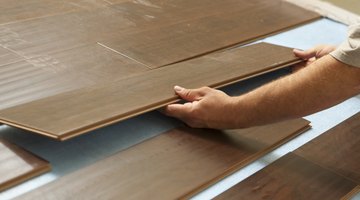How to Remove Laminate Flooring
Laminate flooring is easy to install, and it's even easier to disassemble and remove when it's time to replace the floor. Removing a single damaged laminate plank from a floor isn't quite as easy, though.

Although you can remove an entire floor with virtually no tools at all, you'll need several tools to remove a single plank, and you'll have to use them carefully to avoid damaging the adjacent planks.
Removing Entire Floors
In the early days of laminate flooring, the planks had to be glued together, and if your floor is one of those, you have to cut the planks into pieces with a circular saw to remove them. Set the blade's cutting depth to 1/2 inch. Cut a series of strips from one wall to the opposite one, and then remove the strips and discard them. Most modern laminate floors feature snap-together planks, though, and to disassemble the floor, you simply unsnap the planks. The most difficult part of the procedure is loosening the planks in the row closest to the wall. You may have to melt sealant with a heat gun to loosen these planks.
Disassembly Procedure
Whether you're removing a snap-together or glue-together floor, you need to pry off all the baseboards and transition strips, because they hold the floor down. If the floor is a snap-together one, loosen one of the corner planks by pushing it toward the wall with a rubber grouting float. If it won't move, you may have to sacrifice that plank by tapping it with a hammer and chisel to disengage it from the plank next to it. Once that corner plank is gone, it's usually easy to slide the rest of the planks in that row toward the gap and disengage them. You can then remove the rest of the planks by lifting and unsnapping them.
Replacing a Damaged Plank
If a plank in the middle of your laminate floor gets damaged by a spill or a pet stain, you have two options for removing it. The first is to disassemble the floor back to that board, replace it and put the floor back together. This option calls for extreme care when you're disassembling the floor -- if you break the tongue or groove on any plank, you'll probably have to replace that plank. The other option is to cut out the damaged board and glue in a replacement. You'll need a straightedge, pencil, circular saw, a hammer and chisel, and a sharp knife to do this.
Procedure for Cutting Out and Replacing a Plank
To cut out a laminate plank: • Draw two straight lines an inch apart down the middle, and then draw a 45-degree line from each corner to the nearest central line. • Set the blade cutting depth to 1/2 inch and cut along all the lines with a circular saw, stopping short of the edges to avoid damaging adjacent planks. • Use a hammer and chisel to finish each line, and then pry out the pieces with pliers.
To install a replacement: • Cut the bottom of the side and end grooves from a new plank, using a utility knife. • Spread carpenters glue on the tongues of the adjacent planks with a cotton swab. • Set in the new plank and hold it down with weights until the glue dries.
References
Writer Bio
Chris Deziel has a bachelor's degree in physics and a master's degree in humanities. Besides having an abiding interest in popular science, Deziel has been active in the building and home design trades since 1975. As a landscape builder, he helped establish two gardening companies.
Photo Credits
- Feverpitched/iStock/Getty Images
- Feverpitched/iStock/Getty Images
More Articles



